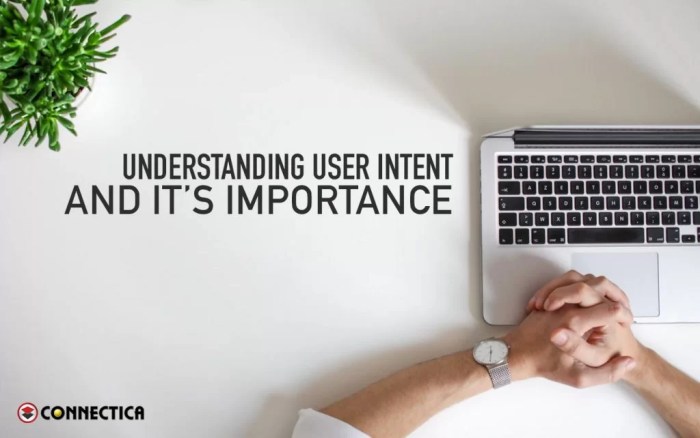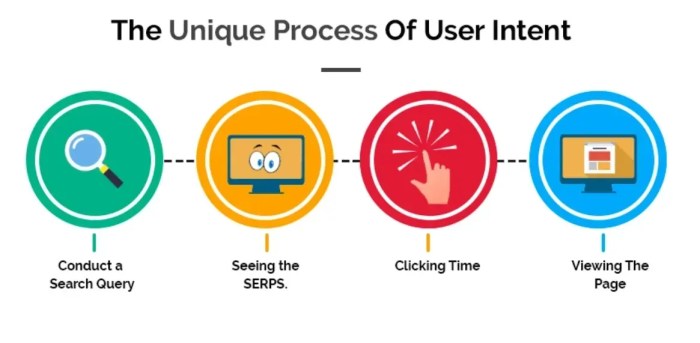Writing for User Intent is all about creating content that resonates with your audience, whether they are seeking information, looking to make a purchase, or simply navigating your site. Dive into this guide to learn how to tailor your writing to meet user needs and drive results.
As we explore the different facets of user intent and how it impacts content creation, you’ll gain valuable insights on crafting compelling and user-centric material.
Understanding User Intent

When it comes to writing, user intent refers to the reason behind a user’s search query or interaction with content. It is crucial to understand what users are looking for when they come across your content.
Aligning content with user intent is important because it ensures that your writing meets the needs of your target audience. By creating content that addresses the specific intent behind a user’s search, you can increase engagement, retention, and overall user satisfaction.
Importance of Aligning Content with User Intent
When you align your content with user intent, you are more likely to attract the right audience to your website or platform. By providing valuable information that directly addresses the user’s needs or questions, you can establish credibility and trust with your audience.
- Creating content that matches user intent can improve your website’s search engine rankings, as search engines like Google prioritize content that satisfies user queries.
- By understanding user intent, you can tailor your writing style, tone, and format to better resonate with your audience, leading to higher engagement and conversion rates.
- Ignoring user intent can result in high bounce rates, as users may quickly leave your site if they do not find the information they are looking for.
Types of User Intent
When creating content, it’s essential to understand the different types of user intent to meet the needs of your audience effectively. User intent can be broadly categorized into three main types: informational, navigational, and transactional.
Informational Intent
- Users with informational intent are seeking answers to specific questions or looking for more knowledge on a particular topic.
- Content that aligns with informational intent includes blog posts, articles, how-to guides, and educational videos.
- When creating content for informational intent, focus on providing valuable and relevant information that answers users’ queries.
Navigational Intent
- Users with navigational intent are looking for a specific website or page to fulfill their needs.
- Content that aligns with navigational intent includes homepage, contact page, product pages, or any content that helps users navigate to their desired destination.
- When creating content for navigational intent, ensure clear and easy navigation options to direct users to the right place.
Transactional Intent
- Users with transactional intent are ready to make a purchase, sign up, or take any action that involves a transaction.
- Content that aligns with transactional intent includes product pages, pricing pages, checkout pages, or any content that encourages users to convert.
- When creating content for transactional intent, focus on clear call-to-actions and compelling offers to drive conversions.
Writing Strategies for User Intent

When it comes to writing for user intent, it’s all about understanding what your audience is looking for and delivering content that meets their needs. Here are some tips on how to write effectively for user intent:
Researching User Intent
To understand user intent, start by conducting thorough research. Analyze s, study search queries, and look at competitor content to get insights into what users are searching for. Use tools like Google Analytics and Google Search Console to gather data on user behavior.
- Identify common search queries related to your topic to understand what users are looking for.
- Analyze the search results for those queries to see what type of content is ranking well.
- Look at the language and tone used in top-ranking content to tailor your writing style accordingly.
Tailoring Content Based on User Intent
Once you have a good grasp of user intent, it’s time to tailor your content to meet those needs. Here’s how you can do it:
- Create content that directly addresses the user’s query or problem.
- Organize your content in a way that is easy for users to find what they’re looking for.
- Use language and tone that resonates with your target audience.
- Include relevant s naturally throughout your content to improve .
User-Centric Content Creation: Writing For User Intent
Creating user-centric content is crucial in today’s digital world where user experience plays a significant role in determining the success of a website or online platform. By putting the user first in content creation, you are ensuring that your content resonates with your target audience, meets their needs, and provides value to them.
Importance of Putting the User First
When you prioritize the user in content creation, you are more likely to engage and retain your audience. By understanding their intent and crafting content that addresses their concerns, questions, and interests, you can establish a strong connection with your users. This not only leads to higher engagement but also boosts your credibility and authority in your niche.
- Conduct thorough research to understand your target audience’s preferences, pain points, and behaviors.
- Use language and tone that resonates with your users, avoiding jargon or complex terms that may alienate them.
- Create content that is easy to digest, visually appealing, and optimized for different devices and platforms.
- Continuously gather feedback from users to refine and improve your content based on their input.
Creating User-Centric Content, Writing for User Intent
To create user-centric content that meets user intent, start by identifying the primary goals and motivations of your target audience. Tailor your content to address their specific needs, whether it’s providing valuable information, solving a problem, or entertaining them. Use data-driven insights and feedback to guide your content creation process and ensure that you are delivering what your users are looking for.
Remember, the key to user-centric content is empathy – putting yourself in the shoes of your audience and creating content that truly adds value to their lives.
Optimizing Content for User Intent
Optimizing your content for user intent involves understanding the different types of user intent and tailoring your content to align with those intents. Whether it’s informational, navigational, transactional, or commercial intent, your content should be structured and optimized to meet the user’s needs at each stage of their journey. Use relevant s, clear calls to action, and engaging visuals to guide users towards their desired outcome and enhance their overall experience on your platform.
- Conduct research to identify the terms and phrases your target audience is using to search for content.
- Analyze user behavior on your website to understand how they interact with your content and make necessary adjustments.
- A/B test different content formats, headlines, and CTAs to optimize for user engagement and conversion.
- Continuously monitor and analyze user feedback and metrics to refine your content strategy and ensure it remains user-centric.
